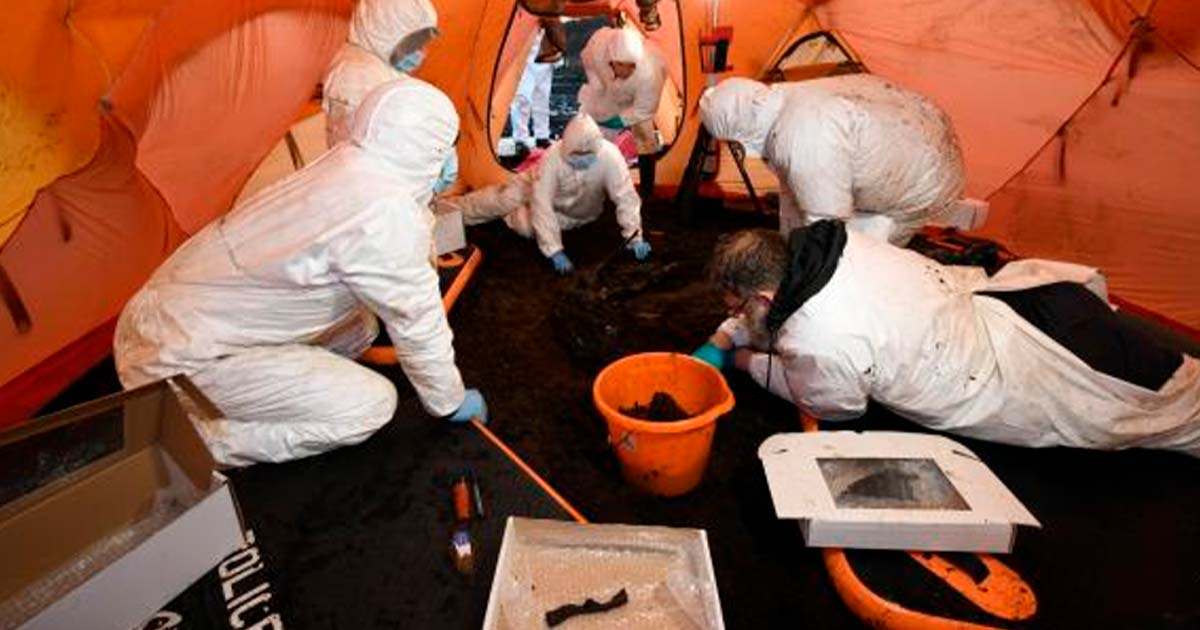Shattered Bog Body Dated To 2,500 Years Old Unearthed
Last October, police in Northern Ireland were perplexed after the discovery of human bones and body parts, in peatland. After extensive tests, it’s now known that the remains were not of a modern murder victim, and that the Irish bog body is in fact dated to over 2,000 years old, and potentially 2,500 years old.
You Didn’t Want to End Up in A Bog!
Violently killed thousands of years ago, “Bog Bodies” is the term used for the corpses of men, women, and children, naturally preserved by the chemistry of Northern Europe’s bogs. When bog bodies are recovered archaeologists and anthropologists down their trowels and act as crime-scene investigators, applying the disciplines of geology, chemistry, and human behavior to reveal the circumstances surrounding these often gruesome deaths.
An example is Lindow Man II, one of several well-preserved human bodies found in a peat bog at Lindow Moss, near Manchester, in 1984, who died a violent death, sustaining many injuries before he was placed face down in a pool in the bog.
- Why Did Ancient Scots Prepare ‘Frankenstein’ Mummies?
- Grauballe Man: Ritual Sacrifice? Justice Dealt? Or a 2,300-Year-Old Murder Mystery?
A Broken, But Well-Preserved Bog Body
The Northern Ireland Police (PSNI) were alerted to human bones lying on the surface of peatland in Bellaghy in October last year. They recovered “a tibia, a fibula, then a humerus, an ulna, and a radius bone from the lower left leg and right arm of a young man.” Then, five meters south of these remains, the bones of a lower left arm and a left femur were identified, and in between the bulk of the remains and the secondary scattering, police found “finger bones, fingernails, part of the left femur and the breastbone.”

Image of left hand bones of the bog body found in Bellaghy, Northern Ireland. (PSNI)
Unlike other bog bodies, this one retained “skin and fingernails on the left hand, toenails and possibly a kidney”. According to a report in the Belfast Telegraph, Detective Inspector Nikki Deehan said when the bones were first examined they weren’t sure whether they were old, or more recent. Therefore, the bones were treated like crime scene evidence, to preserve any DNA that might be lingering on the body parts.
- Lindow Man – What Killed England’s Oldest Celebrity?
- What Killed Grauballe Man? Explaining the Puzzle of the Iron Age Bog Body

Image of the kidney found during the excavation at peatlands in Bellaghy. (PSNI)
Maintaining High Forensic Standards
Detective Inspector Deehan said a forensic anthropologist conducted the postmortem, and that the remains were dated at the 14Chrono Centre in Queen's University Belfast. It was determined that the individual was a male aged between 13-17 years old at the time of death, which occurred around approximately 500 BC, ranging about 2,000 - 2,500 years ago. This result represents “the first time” radiocarbon dating has been used to date a bog body in Northern Ireland.

The total of recovered remains from the Bellaghy bog body. (PSNI)
Dr Alastair Ruffell at the Queen’s University, who the Geogrpahical Society say “has been a pioneer in forensic geoscience for at least 20 years,” told reporters that “the highest possible standards in forensic recovery of human remains were maintained.” Ruffell first carried out two phases of high-resolution ground penetrating radar survey at the find site. And while no further human remains were found, he determined that the one meter (3.28 ft) depth, at which the bones were found, “matches the radiocarbon estimates”.
A Man among Trees
John Joe O’Boyle, Chief Executive of Northern Ireland Forest Service, said: “this is a very exciting find” and that they are now working with National Museums NI to preserve the remains, and interpret the circumstances leading up to the body being left in the bog.
Adding to the mystique of this discovery, the scattered human remains were discovered among the fossilized remains of a tree, suggesting the deceased was buried among a grove of trees.
According to National Geographic, a pattern among the bog bodies recovered in Ireland is that most were buried on the borders of ancient Irish kingdoms. And while many anthropologists think it is merely a coincidence, it has been suggested that the bodies were part of a royal sacrifice ritual, possibly killed to appease the “fertility goddesses that Celtic and Germanic peoples believed held the power of life and death.”
Top image: Experts conducted testing on an Irish bog body found in Bellaghy, dating back over 2,000 years. Source: PSNI
By Ashley Cowie

















